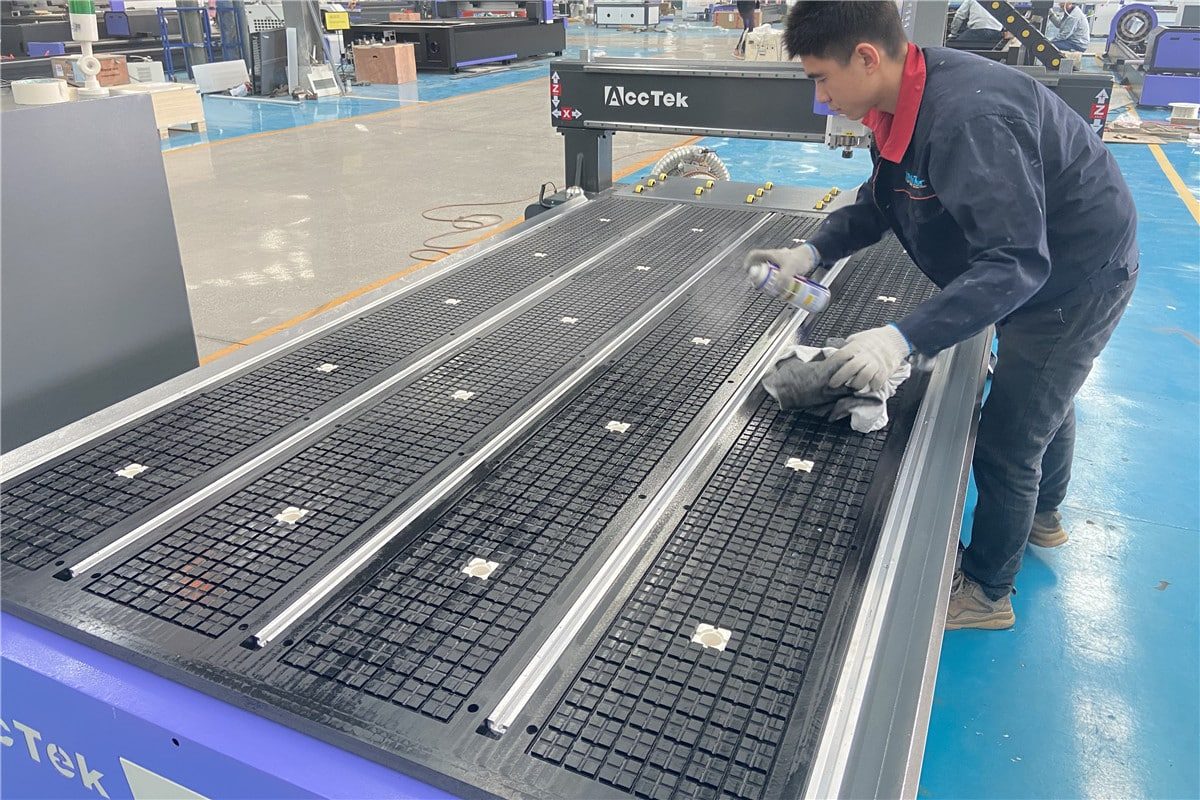Here are some general guidelines for maintaining a CNC router. By following these guidelines and adapting them to your specific CNC router and usage patterns, you can help ensure the optimal performance and longevity of your machine. It's important to note that because different CNC routers may have unique requirements, always refer to the manufacturer's guidelines and the specific maintenance manual for your CNC router when performing machine maintenance.
Daily Maintenance
Clean the Workspace: Remove debris, dust, and chips from the work area, especially around the spindle and guide rails. Use compressed air or a vacuum system to clean hard-to-reach areas. This prevents contamination and ensures accurate CNC router machine movements.
Check Emergency Stop Function: Verify that the emergency stop button is functioning correctly. This is a safety feature that should be regularly tested.
Inspect Tooling: Check the condition of the cutting tool or router bit. Replace or sharpen tools as needed.
Check Tool Changer: If your CNC router has an automatic tool changer, inspect it daily for any issues. Ensure that tools are properly secured, and the tool-changing mechanism is functioning correctly.
Weekly Maintenance
Lubrication: Lubricate all moving parts according to the manufacturer's recommendations. This includes guide rails, ball screws, bearings, and any other components specified in the manual. Use the recommended lubricants and follow the specified intervals for application. Proper lubrication prevents wear and ensures smooth operation.
Inspect Belts and Chains: Check belts and chains for signs of wear, damage, or misalignment. Replace any worn-out components and ensure proper tension as per the manufacturer's specifications.
Inspect Vacuum System: If your CNC router has a vacuum system for dust collection, check and empty the collection bins. Ensure that the vacuum system is functioning properly.
Backup Parameters: Periodically backup the CNC router's parameters and settings. This ensures that you can quickly restore the machine to its optimal configuration in case of a malfunction or after maintenance.
Monthly Maintenance
Check Electrical Connections: Inspect electrical connections for signs of wear or loose connections. Tighten any loose terminals and replace damaged wiring. Ensure that all wiring is secure and in good condition.
Check Tightness: Periodically check and tighten all bolts, nuts, and screws. Vibration and movement during operation can cause them to loosen over time.
Inspect Coolant Systems: If your CNC router uses a coolant system, check coolant levels and ensure that the system is working correctly. Clean or replace filters as needed. Address any leaks or malfunctions promptly to prevent damage to the spindle or other components.
Calibration: Verify the machine's calibration by running test programs. This helps ensure accuracy in the cutting and machining processes.
Quarterly Maintenance
Inspect Spindle: Check the spindle for any signs of wear, unusual noises, or vibrations. If necessary, replace bearings or other worn components.
Check Ball Screws and Lead Nuts: Inspect ball screws and lead nuts for wear and backlash. Adjust or replace components as needed.
Air and Dust System Check: Inspect air and dust extraction systems for efficiency. Clean or replace filters as needed.
Yearly Maintenance
Review Software and Firmware Updates: Check for updates to the CNC router's control software and firmware. Keeping software up-to-date can provide performance improvements and additional features.
Replace Worn Parts: Replace any worn-out components, such as limit switches, sensors, or belts, to maintain the overall reliability of the CNC router.
Re-Calibration: Perform a thorough recalibration of the CNC router. Ensure all axes are parallel and perpendicular as required. Ensure all settings are aligned with the manufacturer's specifications.
Perform Preventive Maintenance: Consider a comprehensive preventive maintenance check, which may include more in-depth inspections and adjustments. Consult the machine's manual for specific recommendations.
General Tips
Create CNC router Maintenance Plan: Develop a short-term and long-term maintenance plan suitable for your CNC router model according to the manufacturer's guidelines. And follow a maintenance schedule for routine maintenance to prevent problems from occurring. Additionally, having a well-documented maintenance plan helps in budgeting and managing costs effectively.
Operator Training and Skills Development: Provide ongoing training for machine operators. Educate them on the importance of routine maintenance, and encourage them to report any unusual observations or issues promptly.
Keep a Maintenance Log: Maintain a log documenting each maintenance task, including the date, the tasks performed, and any observations or repairs made. This log can be invaluable for tracking the machine's health over time.
As the heartbeat of precision manufacturing, a CNC router holds the power to transform raw materials into intricately designed components with unparalleled accuracy. However, the optimal functioning of this sophisticated machinery depends not only on its advanced technology but also on a schedule of regular maintenance. By incorporating these routine maintenance tasks into your CNC router workflow, you can ensure that the machine operates reliably, produces high-quality results, and remains a productive asset in your manufacturing process. Regular attention to these details helps prevent issues before they become major problems, minimizing downtime and ensuring a consistent and efficient production workflow.

Comments on “How to maintain a CNC router?”